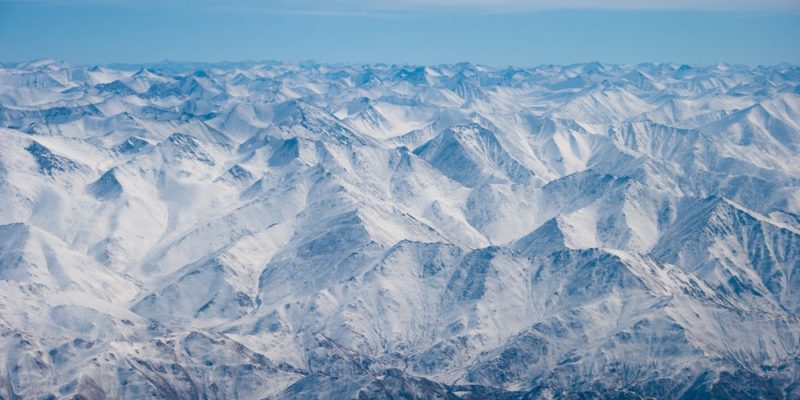We explore the Tertiary Period, and discuss its characteristics and divisions. In addition, we describe its climate, flora and fauna.

What was the Tertiary Period?
Tertiary Period was the name given on the geologic time scale to the first stage of the Cenozoic Era, formerly known as the Tertiary Era, which began 66 million years ago and extends to the present day. However, both terms (Tertiary Era and Tertiary Period) have nowadays fallen out of use.
Currently, the term Cenozoic Era is used to make reference to the total interval of geologic time from the extinction of the dinosaurs to the present time, which in turn is divided into three periods. What was formerly known as the Tertiary Period is now subdivided into two periods: Paleogene and Neogene. The third and last period of the Cenozoic Era is the Quaternary.
During the Paleogene and Neogene periods, mammals diversified and spread across Earth. Hence, the Cenozoic Era (from the Greek kainos meaning "new", and zoe meaning "life", "animal") is also known as "the age of mammals".

- See also: Paleozoic Era
Characteristics of the Tertiary Period
The main characteristics of the Tertiary Period are:
- It began 65 million years ago and ended 1.8 million years ago, spanning a total interval of 63.2 million years, though this periodization has been reformulated in the present time.
- The climate was changing, alternating warm periods with glacial periods.
- Earth's major mountain ranges formed during this period.
- Angiosperms (flowering plants) first appeared, and mammals diversified and spread, earning the Tertiary the name "period of mammals".
- The hominization process began with the emergence of the first primates considered ancestors of the human species.
Disuse of the term Tertiary: In the early 20th century, the terms Tertiary and Quaternary were used to refer to two major periods of the Cenozoic Era. However, in 2008 the International Commission on Stratigraphy (ICS) decided to abandon the use of the term Tertiary. In its place, two new subdivisions were established: Paleogene and Neogene. Nevertheless, the term Quaternary was retained. The subdivision of the Cenozoic was therefore established at Paleogene, Neogene, and Quaternary.
Division of the Cenozoic Era

The Cenozoic Era is divided into three periods, each of which is in turn subdivided into different epochs:
- PALEOGENE PERIOD. It spanned from 65 million years ago to 23.8 million years ago. It comprises three epochs:
- Paleocene. It began 65 million years ago and ended 54.8 million years ago.
- Eocene. It began 54.8 million years ago and ended 33.7 million years ago.
- Oligocene. It began 33.7 million years ago and ended 23.8 million years ago.
- NEOGENE PERIOD. It spanned from 23.8 million years ago to 1.8 million years ago. It comprises two epochs:
- Miocene. It began 23.8 million years ago and ended 5.3 million years ago.
- Pliocene. It began 5.3 million years ago and ended 1.8 million years ago.
- QUATERNARY PERIOD. It spanned from 1.8 million years ago to the present day. It is divided into two epochs:
- Pleistocene. It began 1.8 million years ago and ended 11,000 years ago.
- Holocene. It began 11,000 years ago and extends to the present day.
Geology of the Tertiary Period

Both the Paleogene and Neogene were times of enormous geological and oceanographic changes. In the first place, the breakup of the single supercontinent Pangea was completed, a process that had begun 100 million years before, particularly with the separation of its southern part, known as Gondwana. In turn, the Atlantic Ocean expanded, and North America and South America came together, leading to the formation of Central America.
Other important geological events during the Tertiary were the collision between the Indian and Eurasian plates 50 million years ago, which caused the formation of the Himalayas, the highest mountain range on the planet. In addition, the collision between the African and Eurasian plates caused the Thetis Sea to completely close. As a result of this process, the Alps were formed.
Finally, due to the thrust between the South American and North American plates with the Nazca and Pacific plates, the Andes Mountains formed, extending north-south across the Americas.
Climate of the Tertiary Period
The course of what was formerly understood as the Tertiary Period experienced a major climate transition from the warm, humid conditions of earlier times to a more temperate climate, such as we know it today. Extensive periods of extremely low temperatures known as "glaciations" or "ice ages" dramatically impacted plant and animal life on Earth.
The cooling of the planet began in the wake of the Paleocene-Eocene Thermal Maximum, a time period during the Cenozoic when temperatures reached their highest point in the entire era. This was due to immense amounts of greenhouse gases thrown into the atmosphere over the course of 200,000 years, likely caused by massive volcanic eruptions.
The rise in temperature fluctuated until the end of the Eocene, gradually declining over the Oligocene. The latter period saw the beginning of the glaciation at the poles, which caused their nearly tropical climate to turn into the arid, frozen tundra we know today. By the end of the Miocene, the polar ice caps had fully formed.
Flora and fauna of the Tertiary Period

The early Paleogene, which succeeded the Mesozoic Era, was marked by the mass extinction known as the K-Pg event, a catastrophic episode that led to the extinction of the dinosaurs as well as 75% of animal life on Earth.
At the start of the Tertiary Period, resilient plants that had survived the great extinction, such as ferns and conifers, flourished. Eventually, angiosperms rose and diversified, marking the emergence of flowering plants on Earth. During the Neogene, grasslands diversified and spread, mainly in the temperate and rainy parts of the planet.
Thus, during the Paleogene and Neogene plant life proliferated and diversified, especially during the earlier, warmer, and more humid stages. Later, forests began to give way to drier, more arid areas that spread within the continental interior.
In terms of fauna, the extinction of the dinosaurs favored new animal species, which managed to thrive and spread. In this way, large flightless birds (genus Dyatrima and similar) rose during the Paleocene and Eocene, and mammals diversified, spread, and evolved.
Moreover, during the Neogene the first primates emerged, including the first hominins, ancestors of the human genus. Bovines, antelopes, gazelles, and other large mammals also flourished during this period, as did aquatic mammals like whales.
However, the climate change that took place during the Tertiary had a tremendous impact on marine life: between 30% and 50% of marine species became extinct as ocean temperatures rose. Further marine extinctions occurred in periods when water temperatures plummeted during glaciations, particularly between the Eocene and Oligocene.
Beginning of the hominization process
The first apes or primate-like species emerged during the Tertiary, particularly in the Eocene Period. Various families appeared: Tarsiidae (in Europe and North Africa), Adapidae (in North America and Europe), and Omomyidae (in North America, Europe, Egypt, and Asia). The Asian species were particularly important for human evolution, as they were the possible ancestors of modern monkeys and apes.
Later in time, during the Miocene, the first ape with humanoid traits appeared around 20 million years ago: the Morotopithecus bishopi, in Lake Victoria, Africa. In the Pliocene, these species would have given rise to the first species of Australopithecus, among which are the very ancestors of humans.
Explore next:
References
- AstroMía. (s.f.). El Neógeno. Mioceno y Plioceno. https://www.astromia.com/
- EcuRed. (s.f.). Era Cenozoica. https://www.ecured.cu/
- Gullo, J., Nardulli, J. P., Echeverría, M. J., Capuz, S. M., Lazzaro, Y. (2020). El proceso de hominización. En Ciencias Sociales. Sociedades y ambientes del mundo. De las primeras sociedades al fin de la Edad Media (pp. 139-152). AZ. http://az.com.ar/
- Tarbuck, E. y Lutgens, F. (2005). Ciencias de la Tierra. Una introducción a la geología física. Pearson Educación.
Was this information useful to you?
Yes NoThank you for visiting us :)